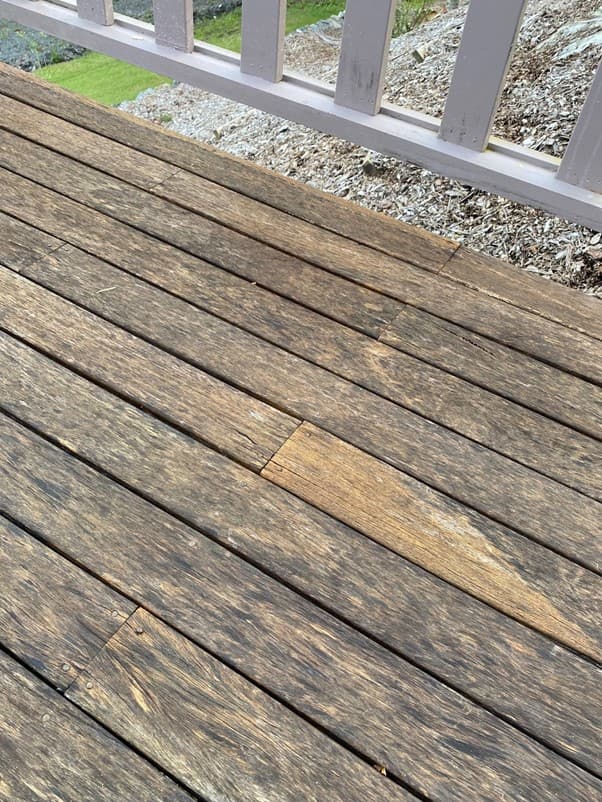Project type
Timber types & determining its condition
When it comes to decking, the type of timber and its condition plays an important role in creating an outdoor space that you'll love and that will compliment your home. From enhancing the look to ensuring durability, making informed decisions about coating selection and addressing the timber’s condition are crucial steps in the deck coating process.
The different timber types
First thing to know is that the timber used for Australian decks falls largely into two groups - Hardwoods and the softwood Treated Pine. Hardwoods like Jarrah, Spotted Gum, and the popular Merbau are known for their exceptional durability and resilience. Treated pine is a softwood that is a versatile and more budget-friendly decking choice.
How to tell what your deck is made from
If you don't know what timber has been used in your deck, follow our 7 steps to help you solve the mystery.
- Check Documentation: If your deck was installed by a previous homeowner or a professional builder, check any available documentation. Original construction records or receipts may specify the type of timber used.
- Visual Inspection: Start by closely examining the colour, grain pattern, and overall appearance of the timber. Different types of timber have distinct visual characteristics. Hardwoods, such as Jarrah or Merbau, often exhibit rich, deep colours and prominent grain patterns. In contrast, softwoods like Pine may have a lighter colour and a less pronounced grain.
- Grain Patterns: The grain pattern can provide valuable clues about the timber species. Hardwoods typically have a tighter, more intricate grain, while softwoods have a more open and straight grain. Take note of the direction and arrangement of the wood fibres, as these can vary significantly between different types of timber.
- Density and Hardness: Gently tap on the surface of the wood with a hard, non-damaging object. Hardwoods tend to produce a sharper, more resonant sound compared to the softer, duller sound of softwoods. Additionally, press your fingernail into the wood; hardwoods will offer more resistance due to their higher density and hardness.
- Knots and Growth Rings: Look for any knots present on the surface of the timber. Different timber species have characteristic knot patterns. Additionally, count the growth rings if visible. Hardwoods typically have fewer, tighter growth rings compared to softwoods, which have wider and more numerous rings.
- Smell and Touch: Close your eyes and take a deep whiff of the wood. Some timbers have a distinctive aroma. The tactile experience is also essential – run your fingers along the surface and feel the texture. Hardwoods tend to be smoother and denser compared to the softer, more porous nature of many softwoods.
- Seek Professional Assistance: If you're still uncertain after undertaking the above steps, don't hesitate to seek professional help. Timber experts or contractors familiar with various wood species can provide valuable insights based on their experience.
Identifying the type of timber is important when considering a coating. For hardwoods, such as Merbau or Jarrah, consider Feast Watson Traditional Timber Oil to enhance the natural beauty while providing essential protection. If you have treated pine, coating it with Feast Watson Timber & Deck Stain offers a protective shield against weathering and moisture while introducing vibrant colour choices to suit your preferences.
Before applying any deck coating, it's essential to evaluate the current condition of your timber. New timber requires different preparation compared to weathered or previously coated surfaces.
New Timber
If you're working with fresh, untreated timber, it's essential to allow it to weather for 4 to 6 weeks before applying any coatings. Weathering is the natural transformation that occurs when timber is exposed to the elements, such as rain, hail, or the sun's heat. This process removes tannins and oils from the timber and is a necessary step for achieving the most aesthetically pleasing deck, with a smooth and even appearance once coated. Once the timber has weathered you can prep with Feast Watson Woodclean.
Weathered Timber
Weathered timber refers to a deck that has naturally aged through exposure to weather elements like rain and sunlight. The previous coating may have completely or partly worn off, and the timber may have a greyish hue. Weathering can make the wood more porous, potentially leading to issues like splintering and cracking, so it's important to apply a coating for protection. Clean the timber with Feast Watson Woodclean and for best results, lightly sand to remove any deterioration.
Previously Coated Timber
If your deck has been previously coated, it's important to assess the condition of the existing coating. Peeling, cracking, or chipping may indicate the need for thorough removal before applying a new coating. Test if your surface is ready by sprinkling water onto the deck. If the water absorbs into the timber, you're ready to start the recoating process. If the water beads, you will need to let your deck weather further, or if you don't want to wait, you can either sand or strip your deck back to bare timber.
Identifying the timber and accessing its condition are essential for achieving a deck you’ll love for years to come. Once you've undertaken these steps, you’re ready to get hands on and begin prepping the timber for a fresh coat.





